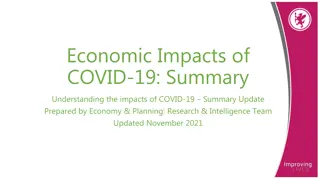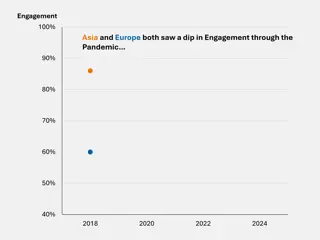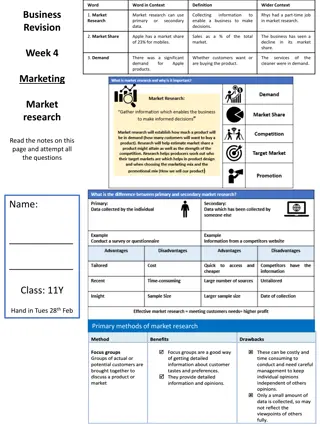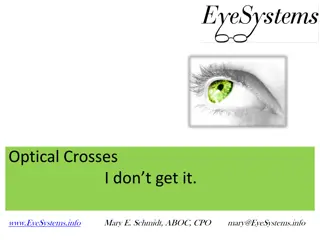Impact of Pandemic on Eyecare Market
The eyecare market faced significant declines at the onset of the pandemic, impacting eyecare professionals, consumers, and optometry practices. With decreases in patient visits, shifts to telemedicine, and changes in consumer behavior, the industry navigated challenges to adapt and respond effectively.
Download Presentation

Please find below an Image/Link to download the presentation.
The content on the website is provided AS IS for your information and personal use only. It may not be sold, licensed, or shared on other websites without obtaining consent from the author.If you encounter any issues during the download, it is possible that the publisher has removed the file from their server.
You are allowed to download the files provided on this website for personal or commercial use, subject to the condition that they are used lawfully. All files are the property of their respective owners.
The content on the website is provided AS IS for your information and personal use only. It may not be sold, licensed, or shared on other websites without obtaining consent from the author.
E N D
Presentation Transcript
Blindsided by the Pandemic The eyecare market experienced huge decreases when the pandemic started. According to a May 2020 survey/report from The Vision Council, monthly adult eye exams declined from 10 million during February to 2 million during April. GPN, a digital data provider for the eyecare market, reported total patient exams decreased 91% YOY during April 2020, but then rebounded to -43% for May. July was much improved at -10%, but the 4% decrease for September increased to -15% for October. According to a late November 2020 survey from Jobson Research, another eyecare data source, 55% of eyecare professionals (ECPs) said they were seeing fewer patients YOY and 41% had lower profitability compared to the same 2019 period.
Eyecare Professionals Remain Focused on Their Patients During the weeks of March 16th, 23rd and 30th and April 6th, more than 50% of ECPs were closed to the public, but the trend quickly improved with 77% open to the public by the week of May 11th. Similarly, 66% of ECPs were able to offer all their services to patients by the week of May 11th, compared to 85% who couldn t the week of March 23rd, 88% the week of March 30th, 83% the week of April 6th, 85% the week of April 13th and 80% the week of April 20th. As with other medical professionals, ECPs quickly pivoted to the use of telemedicine at the outbreak of the pandemic. Of those responding to a mid-2020 survey, 79% said they weren t using telemedicine pre-pandemic, but 88% were when their practices had to close.
Eyecare Consumers Response to the Pandemic According to The Vision Council s COVID-19 US Consumer Study, April 2020, unsurprisingly, had the largest percentage (39.6%) of respondents who said they would postpone or cancel their eyewear purchase until conditions were better, compared to 17.4% for August. Interestingly, the largest group of adults who said they would postpone or cancel an eye exam or a trip to an eye doctor were 18 34 at 36%, compared to 31% of adults 55 64 and 32% of adults 65+. Although many consumers pivoted to online purchases during the pandemic, the percentages indicating they would buy eyewear online didn t vary much: March 15.2%, April 17.7%, May 17.0%, June 15.4%, July 17.0% and August 14.3%.
Inside the Optometry Practice The percentage of optometrists working in private practice decreased to 38.54%, according to CovalentCareers The 2020 Optometrist Report, compared to 45.0% during 2019, while 22.68% were in a corporate practice, compared to 16.45% during 2019. The largest percentages of all survey respondents said their current salary was $110,000 $120,000 and $120,001 $130,000, or 15.4% each; however, for just optometrists, 17.39% said their current salary was $120,001 $130,000, the largest group. The largest percentage (30.3%) of all practice owners responding to the CovalentCareers survey said they spend less than $50/month for marketing and 26.26% said they spend $101 $500/month.
The 2019 Market Overview 2019 retail sales of optical products and services increased 4.9% to $37.47 billion, with the top 50 companies garnering a 41.8% share ($15.67 billion), the top 10 companies a 35.7% share ($13.38 billion) and mass merchants a 10.1% share ($3.79 billion). Among mass merchants, Target and Costco recorded the best optical sales performances, or +14% and +11%, respectively, and with 525 and 529 optical departments, respectively. Various industry leaders indicated patients will expect more engagement with ECPs outside the office setting and more convenience via telemedicine, online purchasing options and mobile eyecare programs.
Pandemic Screen Time and Eyestrain A mid-2020 Foster Grant survey (conducted by OnePoll) revealed the average American s digital screen time had increased 50%, from approximately 4 hours/day pre- pandemic to more than 6 hours/day during the pandemic. With more Americans at home and working and learning on digital screens, eye strain has become a major optical problem. Of the ECPs responding to a late-summer Jobson Research survey, 64% said more patients reported eye problems because of more screen time. An even larger percentage (68%) of surveyed ECPs noticed both adults and children with optical issues as they spend more time viewing one or more screens. A 2020 Versant Health survey found 27.9% of children were experiencing blurred vision from daily screen time.
Advertising Strategies With so many people delaying eye exams and optical product purchases into late 2020, eyecare professionals (ECPs) should consider a robust ad program to reintroduce/reinforce their brand and offer an incentive for a future appointment. To generate more interest among younger adults who schedule their postponed eye exams, promote a Bring-A- Friend program and a voucher for a lunch at a locally owned restaurant once they are safe to patronize again. Once your station is offering NextGen TV advertising opportunities, show the technology to optometrists and local eyewear stores who want to focus their ad messages on households in their immediate neighborhood.
New Media Strategies Although more patients will choose in-office exams/appointments, optometrists can use social media to continue to offer telemedicine as an alternative, especially for older patients, as well as continuing to promote any mobile eyecare programs offered during the pandemic. Create short videos as social media posts explaining the increase in eyestrain due to more time on digital devices during the pandemic and steps to reduce eyestrain, especially among children. Use the table on page 4 of the Profiler, Challenges Selling Eyewear to Children, to target parents with social media content to help them understand these challenges and what the practice/eyewear store is doing to overcome these challenges.




























